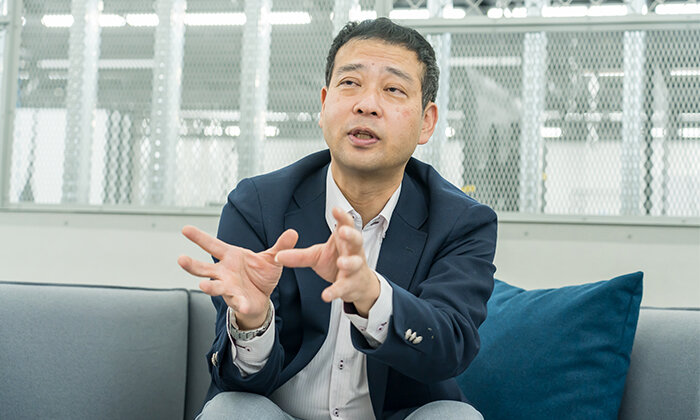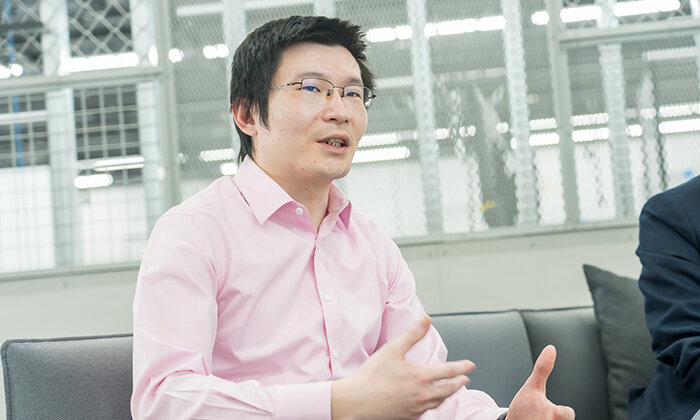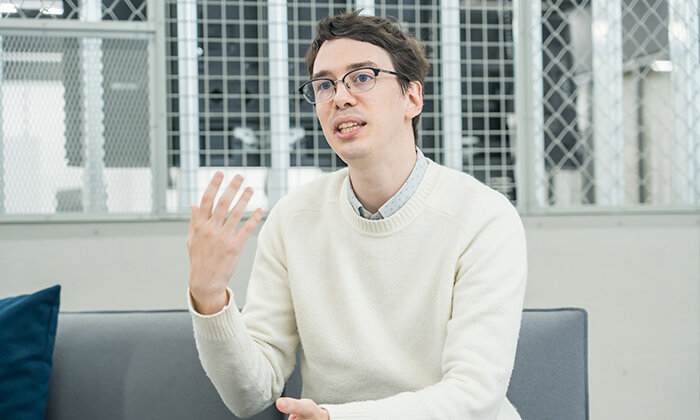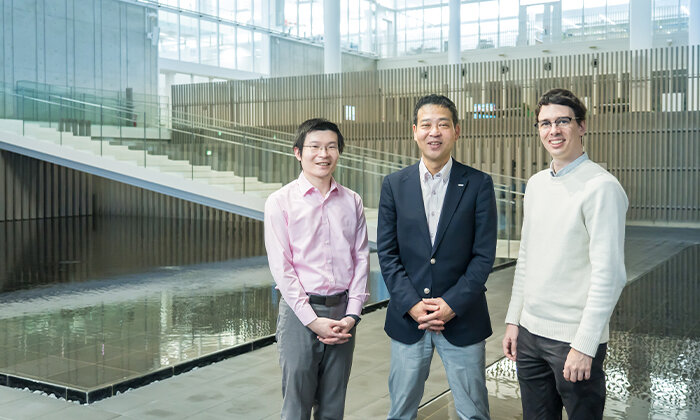
OMRON is helping to create a better society through technologies that combine sensing, control, and thinking. Through this "Sensing & Control + Think" approach and under its long-term vision Shaping the Future 2030 (SF2030), the company is committed to "empowering people through automation" as it continues to pursue ideal ways for humans and machines to relate, with the ultimate goal of solving social issues through its business activities. OMRON believes that if the role of machines can evolve and expand from performing work on behalf of people to partnering with people to bring out human creativity and potential, it will generate vital energy that will feed into solutions to a variety of issues facing society. OMRON's Technology and Intellectual Property HQ is the R&D division of the company charged with generating the innovative new technologies that will be necessary to achieve this. The division's leader, OMRON executive officer Masaki Suwa, identifies development themes with the division's members by backcasting from the near future with the aim of developing more highly human-oriented robots.
Suwa: OMRON is a unique company that has grown while its technologies have changed many aspects of society. The company began with timers for X-ray machines and then expanded its business by developing and providing switches and connectors that were entirely new at the time. From around the middle of the 1960s, OMRON brought to society a succession of new products, including automatic ticket gates, traffic lights with traffic sensors, automated cash dispensers, and electronic blood pressure monitors. These products, which changed the course of society, may appear at first glance to be unrelated to one another, but at bottom they are connected by a certain set of values that pivots on the creation of social needs. What I mean by this is that OMRON developed products that had not existed previously by anticipating what social issues would arise in five or ten years' time during the country's period of high economic growth when many more people would be using train stations, for example.
OMRON carries out business in a diverse range of fields. If we take the products and services in these fields as "branches," then the branches of OMRON are spread out very wide. However, the "trunk" of what we do is create social needs with our unique Sensing & Control + Think technologies for the sake of solving social issues, and this trunk is very thick and well rooted. The Technology and Intellectual Property HQ, which I head, is the R&D division for the entire OMRON group. Our mission is to paint a concrete picture of the near future when certain social issues are solved and backcast from there to envision an architecture of businesses and systems that are needed and then discover and create technologies to make the future a reality. It is very important to take the approach of grasping current customer needs and identifying issues at actual worksites, further evolving current technologies and products, and forecasting to increase customer satisfaction. However, this perspective alone makes it difficult to ascertain latent needs, create social needs, and generate the kind of value that changes society as we know it. Our aim is to take technologies identified by way of backcasting from the near future of society and develop them to make them viable for actual use and then tie them to solving social issues through business.
 "We take on the challenge of technology innovation with ideas and perspectives not confined to the present." (Executive Officer Suwa)
"We take on the challenge of technology innovation with ideas and perspectives not confined to the present." (Executive Officer Suwa)Under our long-term vision SF2030, which fully started last year, we set a goal of "empowering people through automation." This is the essence of the machine as we understand it, and it is rooted in the management philosophy of OMRON's founder Kazuma Tateishi, who said, "To the machine, the work of the machine, to man, the thrill of further creation." Machines do work on behalf of people, but were they really invented to displace work in each and every case? Machines should liberate people from work that is hazardous or exhausting and tasks people are not very good at performing. They should not encroach upon work that people feel is rewarding. Also, machines can perform high-speed, high-precision work that people are not capable of. So, we believe the true purpose of machines is to allow people to devote their time and abilities to creative endeavors or to increase their motivation to do so.
Seen this way, machines are not simply replacements; rather, they have a larger role to play in collaborating in human work and harmonizing with people to help bring out their creativity and potential. Broadening the concept of machine automation with a focus on the relationship between humans and machines, OMRON is taking on the challenge of developing technologies that are more highly oriented to people and that will help lead people to further growth.*1
*1 Site introducing OMRON's technologies
Liu: OMRON has been developing a table tennis robot named FORPHEUS since 2013. This robot is one way in which collaboration and harmony between humans and machines finds expression. I was involved in its development for around four years, since immediately after I joined the company. FORPHEUS returns the ball based on the person's level of ability and is capable of sustaining a rally. The rally, as a collaborative task, was the start of the project, and we have continued to evolve the technology each year. With the sixth generation of the robot, which I helped to develop, it can select the position and speed at which the ball is returned so that it raises the person's motivation and contributes to the growth of the player. In the latest version, the seventh generation, the robot can keep up a rally with two people playing doubles. It reads both people's facial expressions, heartrates, and other attributes and then brings out the performance of the team by raising their level of coordinated play. In this way, the robot is getting close to being a true partner.
FORPHEUS is embedded with core OMRON technologies, our "Sensing & Control + Think" technologies. The robot gathers data with a variety of sensors on the ball's trajectory and speed when it is hit and the player's facial expressions and movements. This is "Sensing." Then, it not only instantly controls the movement of the racket to hit the ball back ("Control"), but it also uses AI to think of a plan for returning the ball that raises the motivation of the player ("+ Think") and based on this chooses a return speed and position.
 "The robot is not viewed as a separate entity; it is put in a larger context with people and the environment." (Liu)
"The robot is not viewed as a separate entity; it is put in a larger context with people and the environment." (Liu)Thibault: For people and robots to exist together in harmony, I think the "+Think" aspect is very important. My research can be broadly divided into two areas. The first is path planning for robots to make smooth, efficient movements. For example, say a robot is instructed to pick up a pen from a desk. People can do this without even thinking about it. But a robot considers a range of motion paths, whether to pick the pen up from the right or the left or whether to pick it up from above. It begins to move only after choosing a path from among these options, which slows down its motion. I am working therefore on getting robots to be faster to compute a solution.
My other research area is robots' situational assessment. For example, a pen is a writing tool, so if the robot understands this, it will pick it up by the cap rather than the barrel when it hands it to someone. Or, for example, when work is being done in tandem with a person, and the person is about to bump into the machine, the machine will stop instantly or change its direction. We're working on getting robots to do this. In order for robots to better coexist with people, they will need to be able to respond in a very flexible way.
Liu: What I've learned in developing FORPHEUS is the importance of not just focus on the robot itself, but with people and the environment. Most industrial robots used in factories are placed in a fixed position and move in a predetermined way according to preset instructions. People learn how to operate the robots and then stay away from them while working to avoid touching them. This is the common practice. Actually, there are still few systems that consider the safety of people nearby, their work status, and other such factors in the industry. And even when they do exist, their decision-making and functioning are slow; they are not very efficient. In this sense, we are working based on the hypothesis that both hardware and systems need to be rethought from the ground up.
Suwa: In the way OMRON envisions robots being used in the world, robots will enter towns, homes, and worksites and be able to function immediately. Ideally, they will be able to be introduced without creating new infrastructure or any additional systems or rules. People generally think of machines as tough masses of steel, but there's no reason why there can't be machines that are soft enough to absorb the impact when people bump into them. This is truly a vision of the future that is discontinuous with our own present. To achieve it would be difficult simply through the growth of the current framework we have for robots. It is a major challenge.
Thibault: The friendly relationship people had with robots in the cartoons I watched when I was a kid made a lasting impression on me; I still remember them very well. When I was little, I thought that a robot like Doraemon would be invented by around 2020. However, we are still a long way from such a world. Overcoming each of the hurdles one by one, I see my job as trying to create robots that will exist naturally alongside people.
 "We are making the brain and motion of robots more flexible so that they can exist in harmony with people" (Thibault)
"We are making the brain and motion of robots more flexible so that they can exist in harmony with people" (Thibault)Suwa: The development of more human-oriented robots being carried out by the Technology and Intellectual Property Headquarters consists truly of the creation of social needs from the standpoint of the near future. There are numerous hurdles between now and the time when robots will be functioning effectively out in the society, and for this reason, we need an organization brimming with positive energy for overcoming them. Even with our approach to robots, there are differences between me in my fifties and the generation Liu and Thibault are a part of. To raise our overall level while exchanging opinions and sharing our knowledge, we are focused on human resource diversity, which includes having employees of different ages, genders, and nationalities, on maintaining an open organization, and creating the conditions that allow individual employees to continually improve their skills.
As one recent initiative, we've begun the process of visualizing the tasks engaged in by each employee. While striking a balance with confidentiality matters, we hold meetings related to decision-making on the start and end of development projects. These meetings are basically open; they are not limited only to project members or people directly involved. The aim is to help other employees come up with new insights and ideas and also to generate enthusiasm. We also have a technology trial program for employees to delve more deeply into their interests. Anyone with a willingness can volunteer to apply; it's a program that supports people who are motivated. The themes that are submitted don't have to be related to your day-to-day work. A certain amount of funding is provided to try things, and then, if a level of success seems forthcoming, a real budget is allocated and the project is made a full-fledged research theme. A pathway is provided for this.
Thibault: I've applied with the technology trial program two times so far. The first time, I put my hat in the ring by myself, but the second time, there were other people who supported the technology, so we formed a team of three and applied together. We are currently working to verify advanced research that could become a future development theme.
We also have a system by which employees learn from each other by sharing their knowledge and specialized expertise. I recruit people who are interested and we hold study sessions on programming languages.
Liu: I earned a PhD at a graduate school after joining the company. My managers and colleagues were very supportive and helped me balance my job here with my academic studies. I am very appreciative of the work environment here; it allows us to grow into even better engineers.
Suwa: To take on social issues together, it is important to build teams with members who create together. We want to convey our dreams and the interesting challenges in which we are engaged and further increase our team members just like flowers attract bees. Our table tennis robot is one such example. It stands as proof of the dedication of OMRON to robot development. Last year, we established ROBOBASE in the Keihanna Technology Innovation Center, a development space that promotes open innovation.
To create an R&D framework to accelerate open innovation globally, in 2018, we established OMRON SINIC X (OSX), an R&D subsidiary that generates innovative technologies based on a vision of the near future. Emphasis was placed on making the company diverse and giving it an organization that is open to society. This was done by hiring young researchers from universities and other companies rather than populating the company with internal transfers from OMRON. OSX carries out research for discontinuous technological evolution while looking even further into the future than the Technology and Intellectual Property HQ. "AI & Robots that Harmonize with Humans to Create Knowledge and Cross Its Borders," a program selected for the government's Moonshot Research and Development Program, is a representative example. This program is conducting research and development based on the vision of generating Nobel Prize-level research results through collaboration between humans and a partner AI robot by 2050. Researchers draw up an experiment plan and the robot performs experiments in accordance with it 24 hours a day on their behalf. The robot searches and analyzes scientific literature data from around the world and provides new knowledge and suggestions in dialogue with the researchers.
In this way, we are carrying out wholly unprecedented R&D on new robots not only at the Technology and Intellectual Property Headquarters but at OSX as well. Co-creation is also underway between the two organizations. I personally look forward to seeing the new value that emerges going forward.
As technology evolves, in certain ways people may be weakened. For example, having a smartphone lets you search for things easily and add to your knowledge, but there are no doubt many people who now have trouble remembering their friends' phone numbers. Given such pros and cons, it is important to think again about what should be left up to machines and what should be done by people. This is why in our SF2030 vision we have the goal of "empowering people through automation." The word "empowering" is used because we intend to actively evolve and enhance the role and value of machines in order for people to play the leading role themselves and be even more creative. The Technology and Intellectual Property Headquarters will continue to take on the challenge of creating social needs, which means robots that are highly oriented to people and draw out human creativity and other abilities. We hope to get even more people on board with these efforts, people both inside and outside our company who sympathize with our approach or for whom our ideas especially resonate, and we hope in particular to get the younger generation interested and involved.
 Profiles of discussion participants (from left)
Profiles of discussion participants (from left)Xiaojun Liu
PhD, Engineering
Voyager Project Dept.
Robotics R&D Center
Technology and Intellectual Property HQ
Born in Shanghai, China. Involved in the FORPHEUS table tennis robot project for four years. For the China International Import Expo held in Shanghai in 2020, developed a system that could sustain a rally with a person and an industrial robot playing doubles against FORPHEUS in order to demonstrate the high level of OMRON's technology and a new form of relationship between humans and robots. Currently involved in robot development that combines arm-type robots with mobile robots.
Thibault Barbie
PhD, Engineering
Voyager Project Dept.
Robotics R&D Center
Technology and Intellectual Property HQ
Born in France. Researched robots and artificial intelligence (AI) at a university in his home country. After graduating, entered a PhD program at a university in Japan and joined OMRON, where he had interned previously, having sympathized with its corporate philosophy. Investigates algorithms related to flexible robotic motion and spends his days installing programs and repeatedly running tests to determine optimal movements. Interested in the cartoons and is drawn to the world they depict in which robots thrive alongside people. Engages in development to make this world a reality.